Investigation on microstructure evolution of clayey soils: A review focusing on wetting/drying process
Cho-Sheng Tng,Qing Cheng*,Xuepeng Gong,Bin Shi,Hilry I.Inyng,b
a School of Earth Sciences and Engineering,Nanjing University,Nanjing,210023,China
b Global Education and Infrastructure Services Inc.,Charlotte,USA
Keywords: Soil microstructure Pore size distribution (PSD)Wetting/drying cycle Suction Volume change
ABSTRACT Variability in moisture content is a common condition in natural soils.It influences soil properties significantly.A comprehensive understanding of the evolution of soil microstructure in wetting/drying process is of great significance for interpretation of soil macro hydro-mechanical behavior.In this review paper,methods that are commonly used to study soil microstructure are summarized.Among them are scanning electron microscope (SEM),environmental SEM (ESEM),mercury intrusion porosimetry (MIP)and computed tomography (CT) technology.Moreover,progress in research on the soil microstructure evolution during drying,wetting and wetting/drying cycles is summarized based on reviews of a large body of research papers published in the past several decades.Soils compacted on the wet side of optimum water content generally have a matrix-type structure with a monomodal pore size distribution(PSD),whereas soils compacted on the dry side of optimum water content display an aggregate structure that exhibits bimodal PSD.During drying,decrease in soil volume is mainly caused by the shrinkage of inter-aggregate pores.During wetting,both the intra-and inter-aggregate pores increase gradually in number and sizes.Changes in the characteristics of the soil pore structure significantly depend on stress state as the soil is subjected to wetting.During wetting/drying cycles,soil structural change is not completely reversible,and the generated cumulative swelling/shrinkage deformation mainly derives from macro-pores.Furthermore,based on this analysis and identified research needs,some important areas of research focus are proposed for future work.These areas include innovative methods of sample preparation,new observation techniques,fast quantitative analysis of soil structure,integration of microstructural parameters into macro-mechanical models,and soil microstructure evolution characteristics under multi-field coupled conditions.
1.Introduction
Natural soils experience alternating conditions of temperature and moisture which are likely to be influenced in the long term by climate change(Tang et al.,2021).These conditions have significant impacts on both soil microstructure and macroscopic properties.Generally,the hydro-mechanical behavior of cohesive soils is sensitive to changes in moisture.If the water content increases,the soil will swell,and its strength will decrease.If the water content decreases,the soil will shrink and even crack.The presence of cracks in soil can significantly reduce soil integrity,weaken soil mechanical strength and increase hydraulic conductivity.Cracks can cause various geotechnical and geo-environmental problems,including landslide,debris flow,dam/embankment break,landfill liner leakage and so on.Soil cracking caused by severe droughts damaged buildings and resulted in enormous economic loss in Nanyang region of China (late 1970s) and in Europe (early 1990s)(Lloyd-Hughes,2002;Lu et al.,2008).During an extreme drought in Southwest China in 2010,the runway at Kunming International Airport was severely damaged due to ground subsidence.The ground subsidence is caused by the significant shrinkage of the clay foundation triggered by drought and evaporation(Bahar and Kenai,2008).
Most soils are unsaturated in regions that are affected by alternating wet/dry seasons.The hydro-mechanical behavior of unsaturated soil is quite complicated as it contains four different phases,namely solid,liquid,gas and contractile skin.The classical soil mechanics model cannot solve all the problems encountered in practice.In some cases,it is necessary to consider effects of soil composition and structure.Generally,soil structure refers to soil particle size distribution,and arrangement and contact patterns.In soil mechanics,sand and silt soil particles are often assumed to be rigid.Deformation is mainly due to the change of arrangement and contact between particles.A well-known example in unsaturated soil mechanics is that of Alonso et al.(1990) who extended the Cambridge constitutive model to unsaturated soils using independent stress state variables (net stress and suction) and established a general yield surface.This extended constitutive model is referred to as Barcelona basic model(BBM)and widely accepted by academia.Subsequently,Alonso’s team improved it and proposed a two-level-structure known as the elasto-plastic constitutive model,namely Barcelona expansive model (BExM),which takes into full account the influence on soil macro characteristics by distinct levels of structure (Gens and Alonso 1992;Alonso et al.,1999,2005).Alrawas and McGown(2011)emphasized the crucial role of soil microstructure in soil engineering properties.Mitchell and Soga (2005) presented that the ultimate goal is to predict the mechanical behavior of soil masses in terms of the characteristics of the particles themselves.Xie and Qi (1999) regarded soil microstructure as the most fundamental internal factor in all kinds of mechanical properties.
In this paper,diverse literature on terminologies and soil classification systems with respect to volume change behavior is discussed in the first section.Some experimental techniques that are widely used in soil microstructure research are summarized with respect to principles,advantages,disadvantages and conditions of applications in Section 2.Section 3 focuses on the evolution of soil microstructure in drying,wetting and drying/wetting cycles,respectively.Section 4 is a review of some mainstream constitutive models related to soil microstructure.Possible directions of new research are proposed in Section 5.
2.Soil structure and experimental techniques
2.1.Concepts of soil structure
The history of soil mechanics is replete with various perspectives on terminology and its implication of soil used in construction.Soil structure is defined as the arrangement of solid parts of soil and soil pores (Marshall and Holmes,1979).Following this definition,soil structure can be described by analyzing the arrangement of particles,aggregates and their contacts,as well as distribution of soil pores and pore connectivity(Delage et al.,1996;Mitchell and Soga,2005;Romero and Simms,2008).Moreover,many researchers usually use the prefix “micro-”,i.e.“microstructure”,to imply focus on the microscopic scale.The terms “structure” and “microstructure” are used interchangeably in this paper.
For microstructure features analyzed by scanning electron microscopy (SEM),Collins and McGown (1974) established a description system for soil microstructure which still suffices in soil structure research.They proposed three types of microstructure as follows:
(1) Type 1: Elementary particle arrangements,consisting of single forms of particle interaction at the level of individual clay,silt or sand particles or interaction between small groups of clay platelets.
(2) Type 2: Particle assemblages,defined as being units of particle organization,having definable physical boundaries and a specific mechanical function,which consist of one or more forms of elementary particle arrangements or smaller particle assemblages.
(3) Type 3:Pore spaces within and among the features described in Types 1 and 2.
In 1984,Collins (1984) perfected this description system,claiming that individual assemblages can further combine to form the overall or composite microstructure,called nodules,peds,lumps,etc.The above-mentioned soil structure types can be observed by the unaided eye.Therefore,they are excluded from the term “microstructure”.
Many scholars have used the mercury intrusion porosimetry(MIP)to study the pore size distribution(PSD)characteristics of soil samples and found that pore distribution varies in size.Barenblatt et al.(1960) put forward the concept of a dual porosity structure when studying seepage in fractured rock.Subsequently,some researchers(eg.Collins and McGown,1974;Ahmed et al.,1974;Pusch,1982;Delage and Lefebvre,1984;Alonso et al.,1987;Lapierre et al.,1990) imbibed this concept and have interpreted PSD curves with two distinctly different peaks,in most cases,for compacted soils.Gens and Alonso (1992) believed that the two peaks represent micro-and macro-voids,respectively.Many additional studies(Sharma,1998;Delage et al.,2006;Lloret and Villar,2007;Farulla et al.,2010;Nowamooz and Masrouri,2010a,b;Ye et al.,2011)found that the porosity measured by MIP and the real porosity are different due to the limitation of applied pressure interval,i.e.the conventional MIP cannot detect smaller (r<10 nm) or larger(r>400 μm) pores (Romero and Simms,2008).At present,it is generally believed that the pores of clay soils have three levels of configuration:intra-platelet pores,intra-and inter-aggregate pores(Sharma,1998) (Fig.1),correspondingly referred to as micro-,meso-and macro-pores by Nowamooz and Masrouri(2010a).Some intra-platelet voids cannot be measured by MIP.For example,Lloret and Villar(2007)set intra-platelet pore radius in the range of 0.2-2 nm.The boundaries among intra-and inter-aggregate pores vary with the nature and state of soils.Experiments by Ye et al.(2011)showed that the boundaries between inter-and intra-aggregate pores of densely compacted bentonites are in the range of 150-200 nm.However,Farulla et al.(2010) studied PSD of compacted scaly clay and considered that the limitations of inter-and intraaggregate pores are approximately 2 μm.In the literature,there are several methods proposed to distinguish macro-and micropores.Delage and Lefebvre (1984) considered the difference between the intrusion and extrusion curves as the quantity of macropores.Romero et al.(2011) defined the delimiting diameter with the dominant peak of the sample saturated under constant volume(or free swelling)condition.The method proposed by Burton et al.(2015) is based on the threshold entrance pore size defined as the pore size that marks the beginning of the main population of pores.Table 1 summarizes relevant research findings in the literature.However,the data are of high discreteness because the pore structure of soils can be influenced by many factors such as mineral composition,dry density,moisture content,and hydro-mechanical path.
In the early studies,investigators either did not notice threepeak pore distribution or considered that there was no need to study intra-platelet pores.When they used the terms“macro-pore”and “micro-pore”,PSD was considered to be bimodal by default,corresponding to inter-and intra-aggregate pores in three-level structure model,whereas intra-platelet pores were always neglected because of invariability.This hypothesis is still reasonable: it is generally believed that intra-platelet pores are affected only when suction is high enough(more than 3 MPa)(Romero et al.,1999).In most cases,the volume change of the soil is mainly due to inter-and intra-aggregate pores.
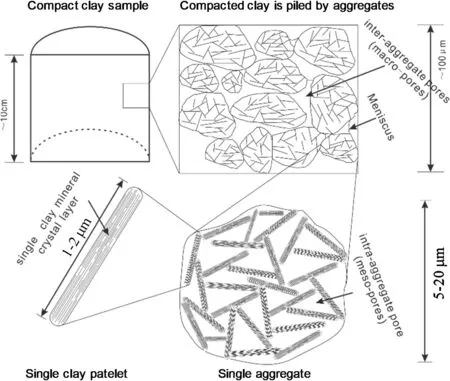
Fig.1.Conceptual model for microstructure of compacted clays,modified from Sharma (1998).
2.2.Experimental techniques in soil microstructure research
Experimental techniques in soil microstructure research include polarization microscopy,SEM,environmental SEM (ESEM),MIP,computed tomography (CT),nitrogen adsorption and others,as listed in Table 2.Of those listed,the most widely used ones are SEM,ESEM,and MIP.In recent years,with the improvement of the resolution of CT technology,CT has been applied more and more in the study of soil microstructure.More recently,investigators of soil structure have focused on macro-pores,compaction behavior,the hydro-mechanical properties of soil and other special characteristics by CT.Even though some researchers use it to study particle trace in soil,the use of CT for micro-scale is still limited(Taina et al.,2008;Grayling et al.,2018;Pöhlitz et al.,2018;Singh et al.,2021).
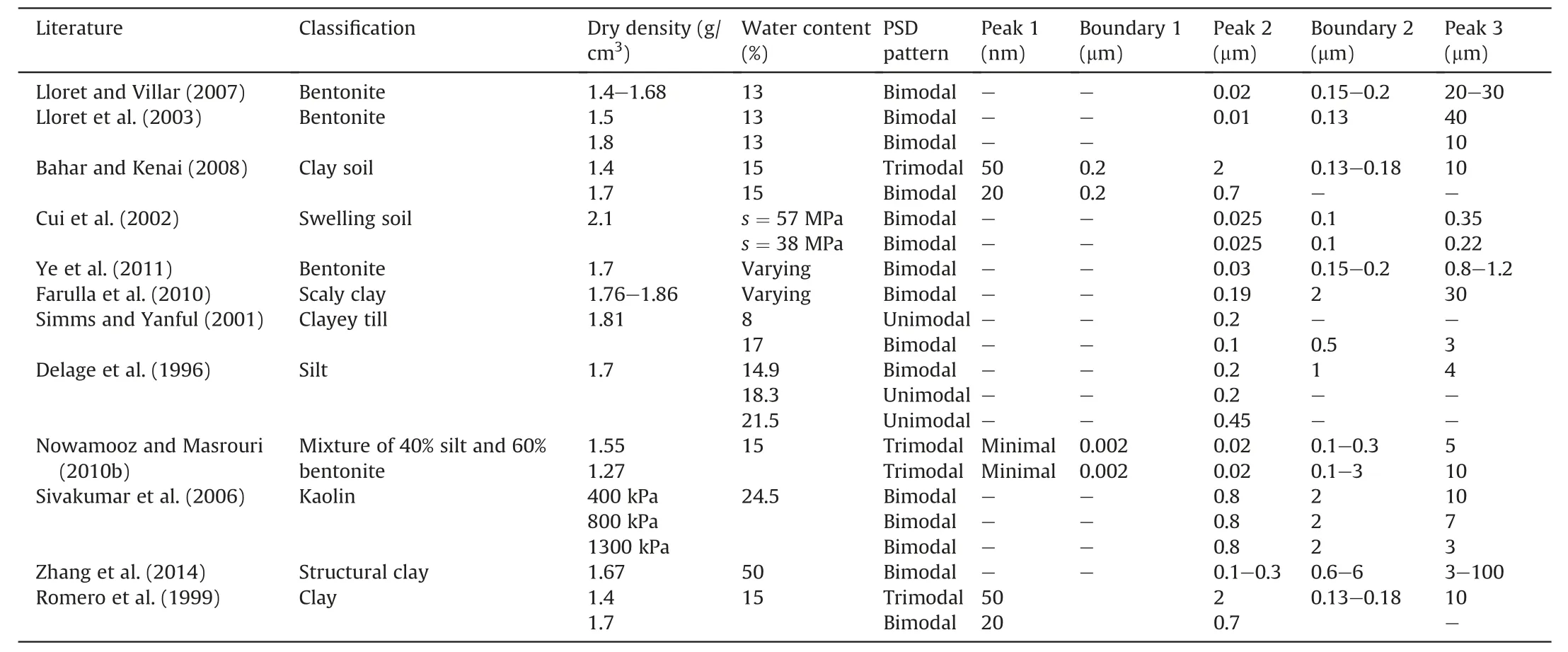
Table 1 Summary of research results about pore structure characteristics from literature.
SEM is the most widely used technique currently in the study of soil microstructure.Due to its stringent requirements on vacuum strength and sample surface properties,SEM still faces many problems in practical use:
(1) Harsh requirements and complex processes.
(2) Disturbance of soil structure during sample preparation process.
(3) Requirement for conductivity treatment on non-conductive sample surface.Generally,carbon powder or gold powder is sprayed on it to avoid charge accumulation.However,the observation does not necessarily reflect the real surface structure after spraying.
(4) The presence of water is not allowed because of strict demand of a vacuum.Freeze-,air-,or oven-drying is adopted to deal with the soil sample.The treating process may affect the soil structure,so that the surface of a sample cannot be observed under its natural state.
Currently,the freeze-drying technique is the most commonly used one since it appears to have negligible damage to the microporosity (Penumadu and Dean,2000).ESEM is a modified SEM.In the use of ESEM,neither conductivity treatment nor vacuum environment is required.Each sample can be observed directly under its natural state.This is an ideal technique for investigation of soil microstructure evolution in wetting/drying conditions.However,ESEM also has some limitations.For example,its resolution may be affected by high humidity;magnification is often less than 5000 times;and for a sample with a high water content,it is difficult to obtain and post-process high-quality images through ESEM.
Regardless of whether it is SEM or ESEM that is used,the morphology of particles and pores can only be investigated qualitatively before the application of digital image processing technique in quantifying textures and structures as currently done.Many researchers have tried to introduce computer image processing techniques into the quantitative study of soil microstructure and have made significant achievements (Alrawas and McGown,2011;Liu et al.,2011;Xu et al.,2016;Tang et al.,2020).The obtained geometrical and morphological indices of soil particles/pores in microscale include area,perimeter,equivalent length,equivalent diameter,roundness,morphology ratio,number of elements in a certain area,apparent porosity,anisotropic rate,fractal dimension and probability density function (Tang et al.,2020).It should be noted that the quantification results are influenced by many factors such as the SEM image size,magnification and threshold selection (Tang et al.,2020).
The rationale for the use of MIP is the non-wetting contact between liquid mercury and soil particle surface.Before MIP test,freeze-,air-or oven-drying is also needed to dehydrate the soil samples.Mercury can enter soil pores only if a certain minimum pressure is applied.The amount of the pressure required is related to the pore size.Washburn(1921)derived the following formula to describe the relationship between intrusion pressure and pore diameter:

wherePis the intrusion pressure(Pa),γ is the liquid surface tension(N/m),θ is the contact angle (°),anddis the pore diameter (m).Combined with the volume of liquid mercury intruded,the relationship between pore size and volume can be established.During the process of intruding mercury into soil pores,pore structure is not altered significantly (Lawrence,1978;Acar and Olivieri,1990;Romero and Simms,2008).The test period of MIP is short,and the data are relatively reliable.This relationship has continued to play an important role in quantitative analysis of soil microstructure,especially in PSD.However,MIP still has some limitations: (1)completely closed pores cannot be measured;(2) ink-bottle effect which ensures that no matter how large a certain pore inside the sample actually is,it can be filled only if the smallest pores in the path from the sample surface to the pores are filled;(3) the maximum pressure that can be applied by the instrument is not sufficient to intrude mercury to enter all the intra-platelet pores;(4)minimum/large pressure applied by the instrument restricts the maximum/minimum pore size (Romero et al.,1999).
CT is a non-destructive test technique which can be used to investigate the microstructure evolution of soil sample under a certain stress state with a certain time interval.When a beam of photons passes through a material with different densities,a sectional image of the sample can be reconstructed by using a specific algorithm based on the attenuation coefficients of X-rays,γ-rays or neutrons.A series of sectional images can be used to construct three-dimensional (3D) images of the internal structure of the sample.The CT machine was initially used for medical diagnosis.Subsequently,its use was expanded to various fields such as engineering,biology,agronomy,physics,chemistry,etc.
X-ray is the most common radiation source in practical CT applications.However,it is difficult to differentiate pore water and pore air using X-ray due to poor absorption contrast.In order to investigate water distribution in unsaturated porous materials,some researchers used CsCl-doped water to replace pure water(Wildenschild and Sheppard,2013).Moreover,neutron-rays are very sensitive to the presence of water (strictly speaking,the presence of hydrogen),so that it is more responsive to the changes in moisture than X-rays or γ-rays(Lopes et al.,1999).Therefore,in recent years,more and more researchers have used neutron-ray tomography (neutron-ray CT) to study the flow of water in unsaturated soil (Deinert et al.,2004),the migration of fluids in sandstone and soil pore characteristics(Solymar and Lehmann,2003),as well as water flow among soil aggregates(Carminati et al.,2007).

Table 3 The effective stress parameter χ expressed piecewise according to water content(Nowamooz et al.,2016).
CT technology has many advantages over other soil microstructure test techniques,which involve non-destructiveness,continuity of test processes,and detection of 3D features.Additionally,CTcan be used to analyze various properties of soil samples such as deformation,faults,fractures,fluid migration and permeability(Shi and Jiang,2001).Most previous researchers focused on macropores,density,hydraulic properties of sand and so on.Recently,micron-level and even nano-level CT technology is beginning to emerge,which is applied in the area of geotechnical microstructure gradually (Taina et al.,2008).With the advancement and innovation of technology,CT technology with higher accuracy and resolution will help investigators to better understand the microscopic world of soil.
3.Soil microstructure evolution in wetting/drying processes
Many studies have shown that the load and suction as well as the coupling between them are the main determinants of soil microstructure evolution.Thus,analyses of wetting/drying processes are helpful in understanding the macro-mechanical phenomena such as deformation and failure of unsaturated soils.This can also bring closure of gaps between constitutive models and physical manifestations of soil deformation.In this section,the effects of soil suction changes,i.e.drying/wetting condition changes,on soil microstructure are discussed.
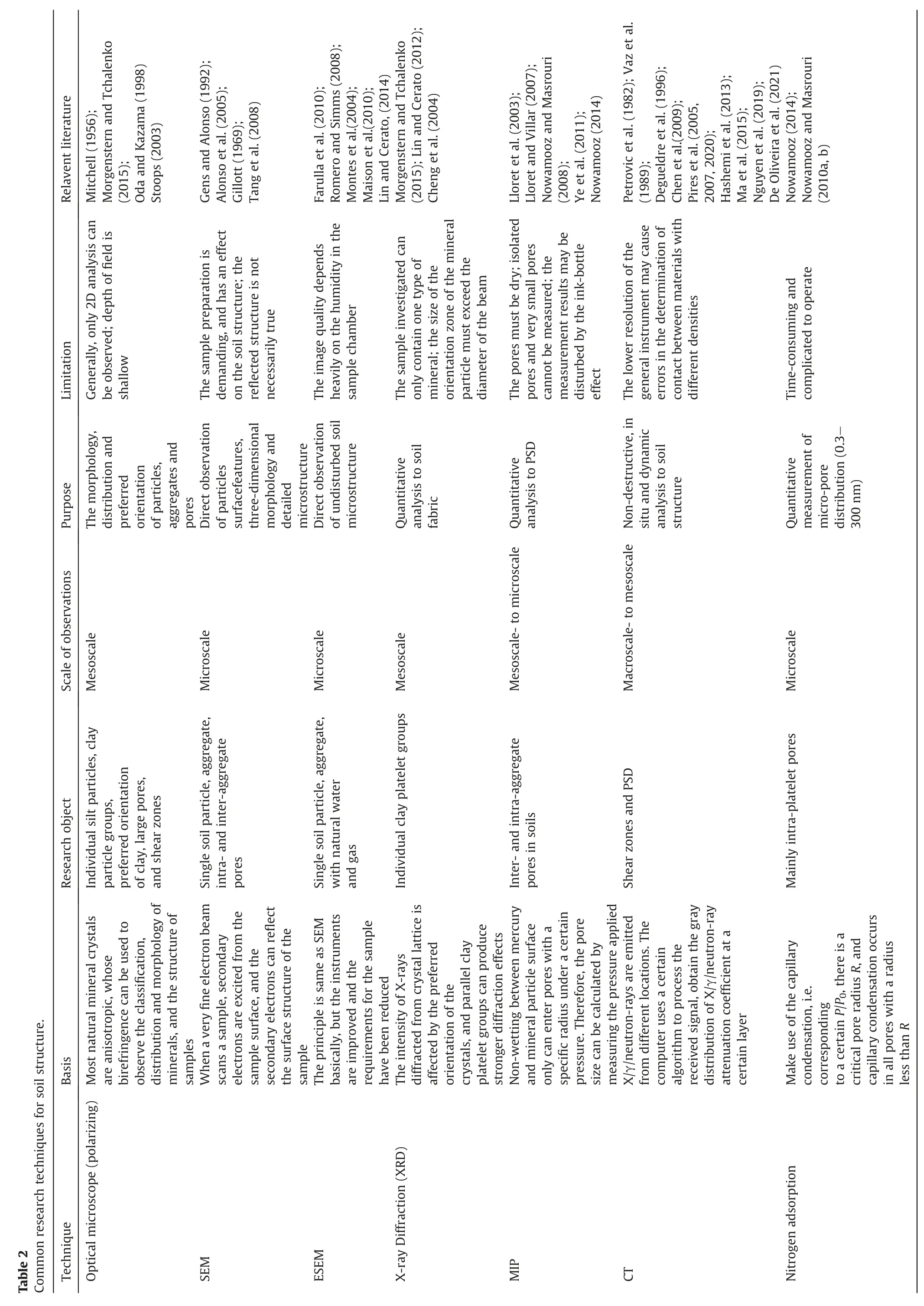
Under different water contents,there are obvious differences in the microstructure of cohesive soils.Delage et al.(1996) used MIP and SEM to study the soil microstructure of compacted silty soil samples under the same dry density but different water contents.They reached the following conclusions.On the dry side of the optimum moisture content(water content lower than the optimum moisture content),there is a well-developed aggregate structure with soil aggregates as the skeleton and clay bridges as connectors.An inter-aggregate porosity is visible.The clayey fraction is not well-developed,not apparent on SEM,and coats the grains or forms grain joint infills.When the water content is equal to the optimum water content,soils tend to have a more massive structure.Compared with that obtained on dry side,the size of aggregate is smaller,aggregate structure is less obvious,and inter-aggregate pores decrease significantly.The clayey soil fraction works as coating outside aggregates and as connectors between aggregates.With the same compaction effort as imposed on dry soil,the greater density obtained is the result of the lower resistance to deformation of the aggregates,which deform and break down more easily,reducing in particular the inter-aggregate porosities.On the wet side,a microstructure develops in which wetter clay serves as a matrix that envelops the silt grains and fills intergranular voids.The only population of voids found in porosimetry in this case is that of the clay matrix.These conclusions are consistent with the experimental results obtained with MIP:on the dry side,the pore distribution function has a distinct bimodal feature;and on the wet side,it shows a clear unimodal distribution.Many experiments have produced similar results (Wan and Gray,1995;Delage et al.,2006;Sivakumar et al.,2006;Tarantino and Col,2008;Farulla et al.,2010).Farulla et al.(2010) investigated the microstructure of clay using MIP and SEM/ESEM.The images were analyzed using the digital image processing technique to show the shrinkage of particles and aggregates during wetting/drying processes.Fig.2 shows the relationship between particle deformation and suction change.It was found that the decrease in suction (increase of water content) caused aggregates to expand and increased suction (decreased water content),which shrunk them in turn.
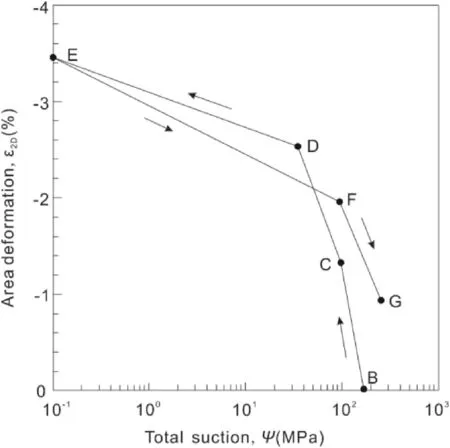
Fig.2.Area deformation of the aggregate versus total suction in wetting/drying process (Farulla et al.,2010).
In addition,the deformation of aggregates on the wetting and drying paths shows some hysteresis,i.e.after a complete suction cycle,there is accumulated swelling or shrinkage.In fact,the relationship between water content and soil microstructure is not static and unique,but is closely related to drying/wetting paths.Therefore,to understand the macroscopic properties of the soil deeply,it is of great significance to analyze and discuss the evolution of soil microstructure during the drying process,wetting process,and drying/wetting cycling.
3.1.Drying process
During drying process,the suction of soil increases,and the total volume decreases.This is mainly caused by the significant shrinkage of macro-pores,while the micro-pores are unchanged or slightly increased.The results of experiments conducted by Cuisinier and Laloui (2004) showed that the reduction of total porosity before the shrinkage limit was mainly caused by shrinkage of macro-pores.Remarkably,the micro-pores increased slightly due to shrinkage of macro-pores and led to a decrease in constraint among aggregates.After the shrinkage limit,the total porosity stayed constant,but the PSD was still changing.Only the decrease of macro-pores and the increase of micro-pores were equal,i.e.the soil microstructure was still evolving.In addition,pores smaller than 0.1 μm did not change throughout the drying process.Many studies have reached similar conclusions(Simms and Yanful,2001,2002;Koliji et al.,2006;Zeng,2007;Ye et al.,2011).Based on previous test results,Cuisinier and Laloui (2004) plotted the evolution of PSD during the drying process of sandy loam (Fig.3).Regarding 0.2 μm as the boundary of macro-and micro-pores in the test,Cui et al.(2002) drew the relationship between macro-pore ratio and suction,as shown in Fig.4.It reflects the conversion process from macro-pore volume to micro-pore volume.However,when drying induced internal micro-fissures occur,a different PSD evolution can be observed.Sun and Cui (2018) found that with further drying to lower water content (lower than the shrinkage limit),micro-fissures in interface between silt grain and clay particles and in clay fractions result in an increase of pore size.
Nowamooz and Masrouri (2010b) quantitatively studied the change of macro-,meso-and micro-pores during soil drying process by MIP.The results are shown in Fig.5.Within the suction range of 0-2 MPa,the change in void ratio is mainly controlled by the macro-pores,that is,the macro-pores are only affected in this suction range.The macro-and meso-pores are affected by the suction range of 2-60 MPa.When the suction exceeds 60 MPa,the deformation mainly comes from the meso-and micro-pores.
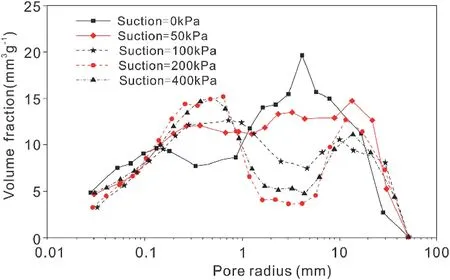
Fig.3.The evolution of PSD in the drying process of a sandy loam (Cuisinier and Laloui,2004).
Cai et al.(2015) described the microstructure evolution of compacted clays with three-level structure in the drying process.They divided the drying process into five phases:
(1) During increase in suction from zero to the air entry value,the continuous increase in suction causes the soil to shrink.The level of soil shrinkage is equal to the amount of water that seeps out.Therefore,the soils remain saturated.At this stage,the flow of water only is limited to the macro-pore water while the meso-pore water content does not change significantly.
(2) After the suction exceeds the air entry value,the water in the macro-pores seeps out and the soil becomes unsaturated.The outflow of macro-pore water induces rearrangement of the aggregate to a more compact state,which also results in an increase in the stiffness of the soil as the volume decreases.The suction range at this stage corresponds to the suction range of 0-2 MPa in Nowamooz and Masrouri(2010b).
(3) After the water in macro-pores flows out completely,the water in the meso-pores begins to flow out,and the water content further decreases,but the volume no longer changes.
(4) After all the meso-pores are drained,the soil suction is already very high.Micro-pores between crystal platelets are the final storage site for water (the inter-platelet water is responsible for the swelling of the clay particles themselves),and only a very small amount of inter-platelet water leaves.
(5) Water molecules between the crystal platelets further reduce,and the water content approaches a constant value that is close to zero.
Comparing the results of Cai et al.(2015) and Nowamooz and Masrouri (2010a,b),many similarities can be found but they are not completely identical: Cai et al.(2015) thought that only one kind of pores is drained in each drying phase,while Nowamooz and Masrouri(2010a,b)considered the phases in which different levels of pores play a dominant role to be overlapped.These differences in observations and assumptions warrant more investigations.
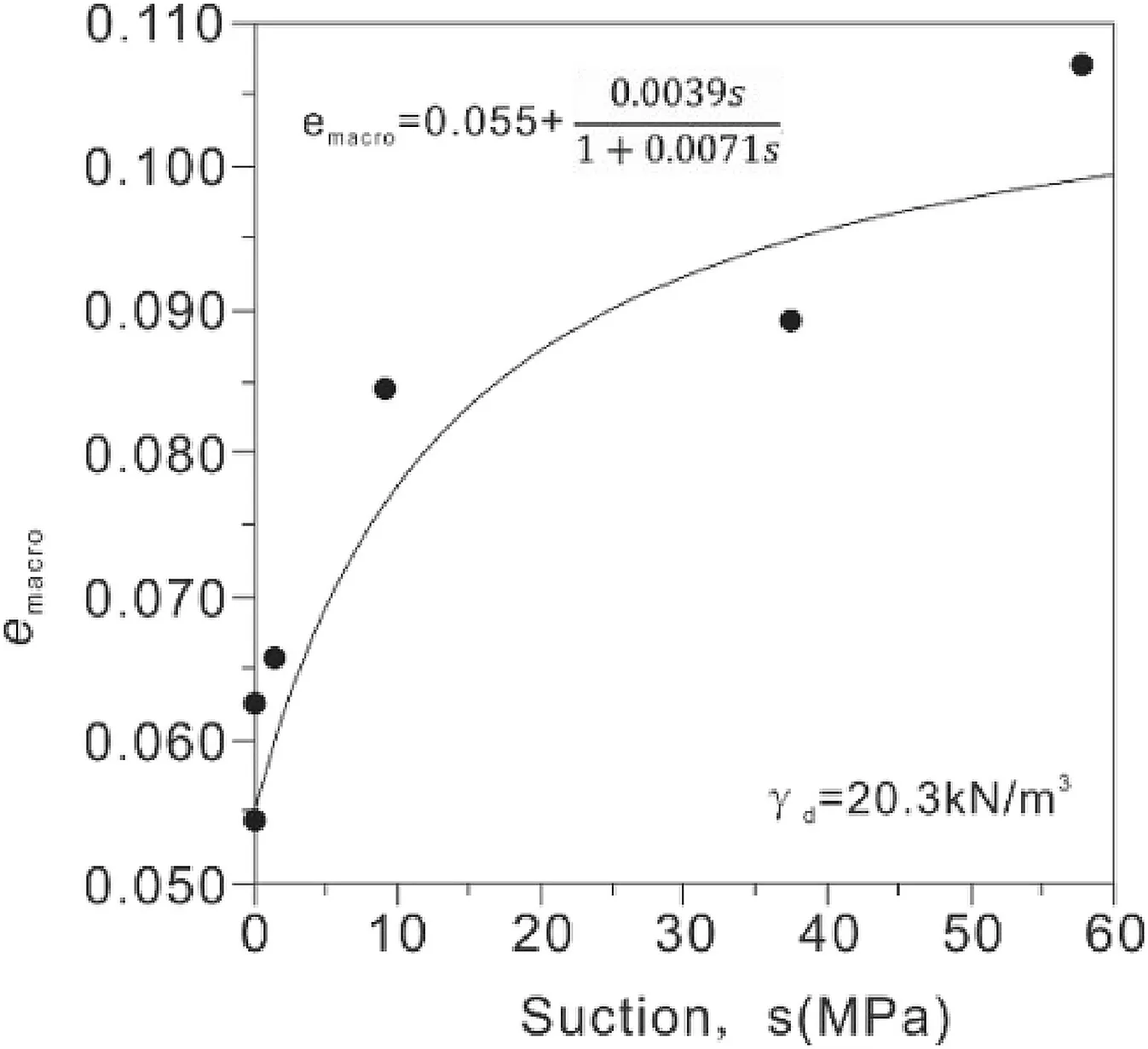
Fig.4.Macro-pore ratio versus suction in drying process (Cui et al.,2002).
In addition to qualitative descriptions,investigators have also worked on quantitative mathematical models for description of the evolution of PSD curves in the drying process.Koliji et al.(2006)summarized a large number of experimental results of soil drying trying to predict PSD curves.The PSD curves under two limit cases are shown (suction=0 kPa and 400 kPa,i.e.saturated case and driest case) to determine the modification of the PSD curves for intermediate cases,as shown in Fig.6.The proposed model divides PSD into three pore classes (micro-and macro-pores,and nonaffected areas).Using the concept of suction influence domain,Fig.6 is divided into four regions:Zones 1 and 4 are related to the pores which are only slightly affected by the suction,based on which the influence of suction can be neglected.Zone 2 corresponds to the micro-pores,and the volume fraction of these pores increases as suction increases.The pore volume fraction of the pores that belong to Zone 3 reduces as suction increases.The behavior of these pore classes is different and they should be distinguished in the model formulation.
Some scholars have proposed a theoretical model that can simulate the PSD evolution in drying process.In the model established by Huang et al.(2017) based on the experimental data,the PSD curve after suction increase can be obtained from the initial PSD curve through translation,scaling and dispersion in three steps.The levels of translation and scaling are linearly related to the void ratio,while the degree of dispersion and void ratio are exponentially related.
3.2.Wetting process
Many studies have shown that the evolutionary characteristics of soil microstructure in wetting processes are closely related to wetting conditions.Under unconfined condition (free swelling),aggregates swell and split into smaller aggregates.Both the intraand inter-aggregate pores tend to increase,and the former is dominant(Ye et al.,2011).In confined wetting(commonly constant volume wetting),inter-aggregate pores gradually become closed,the volume decreases,and the volume of intra-aggregate pores increases(Cui et al.,2002;Liu,2016).Cui et al.(2002)and Liu(2016)asserted that the separation of clay sheet in aggregates and the swelling of clay particles during wetting lead to transition from bimodal PSD to unimodal PSD and the homogenization of soil structure.
Soil microstructural change during wetting depends on the migration and occurrence of water in soil pores,and can be analyzed from the pore structure and macro-mechanical phenomena.Lloret et al.(2003)and Sivakumar et al.(2006)studied soil PSD characteristics under different wetting/drying paths and isotropic compaction conditions,and they obtained the following consistent results: (1) as the pressure increases,the peak of intraaggregate pores does not change,however,the peaks of interaggregate pores decrease;(2) within the range of high suction,compaction has almost no effect on the soil-water retention curve(SWRC).They can be explained as follows: when wetting under a given suction,water is taken up largely by the intra-aggregate pores first,and the compaction does not affect the intra-aggregate pores.Therefore,in the range of high suction,compaction does not affect the relationship between water content and suction.On the contrary,in the range of low suction,water already exists in the intraaggregate pores,while the inter-aggregate pores subjected to high pressure is compressed.
In addition,the evolution of soil microstructure in wetting has been discussed from the stress-strain perspective.It is reported in literature that the swelling gradient κ is about 0.1 in the reconstituted unsaturated kaolin(Sivakumar et al.,2006).κ is the slope of the unloading curve when the specific volume of the sample is plotted against the natural logarithm ofp-uw,wherepis the compaction pressure anduwis the pore water pressure.However,it can reach 0.03 after saturation(Sivakumar et al.,2002).This implies that when unsaturated,the soil aggregates are separated from one another and play a supporting role as rigid body-like particles.Since the contact area between the particles is small (Fig.7),the confining pressure is small such that the stiffness is lower and the κ value is higher.When gradually saturated,the aggregate particles gradually become dispersed,and expand into the inter-aggregate pores.At this time,the contact areas with one another are larger.It is no longer just the deformation of some isolated contact points,but overall compression.Therefore,the stiffness is higher,and κ is lower.
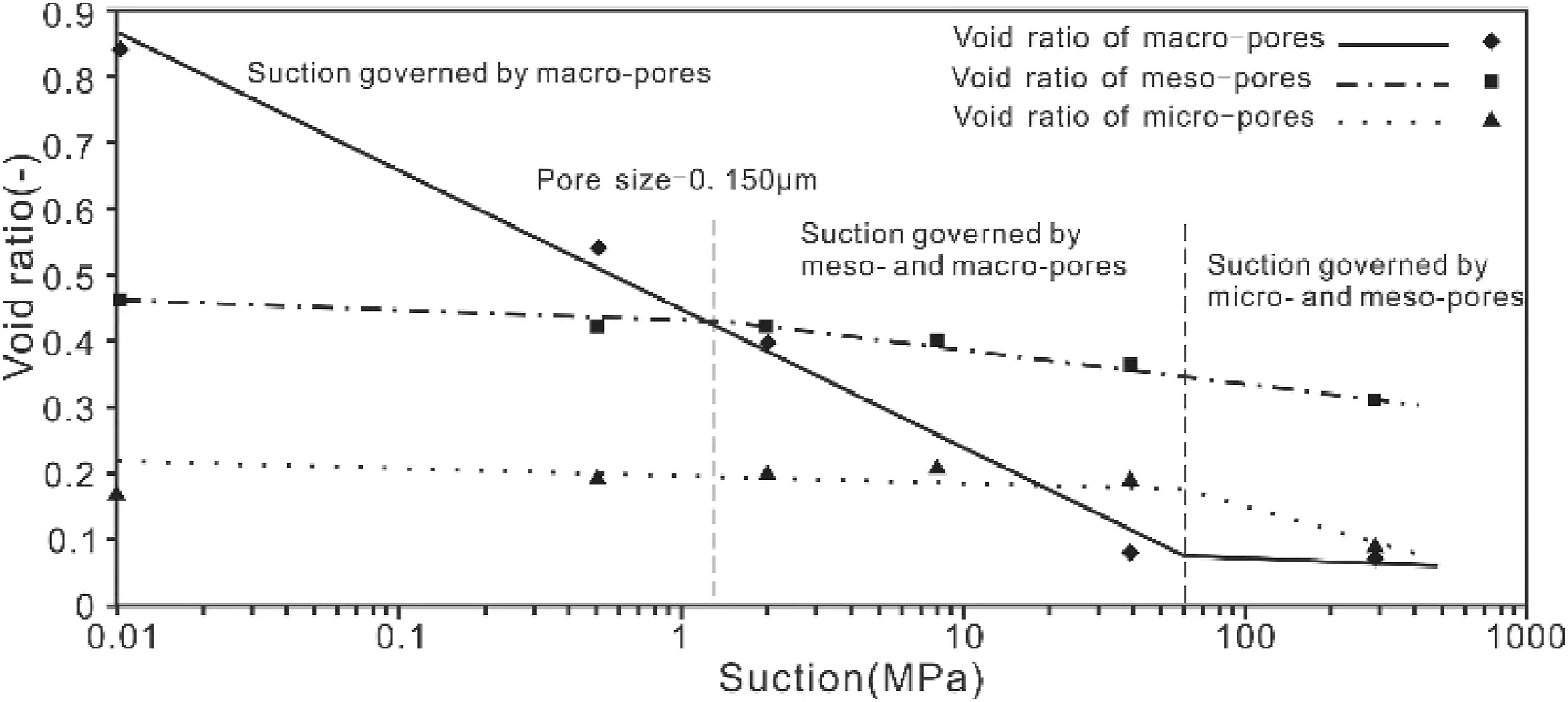
Fig.5.Void ratio of macro-,meso-,and micro-pores versus suction (Nowamooz and Masrouri,2010b).
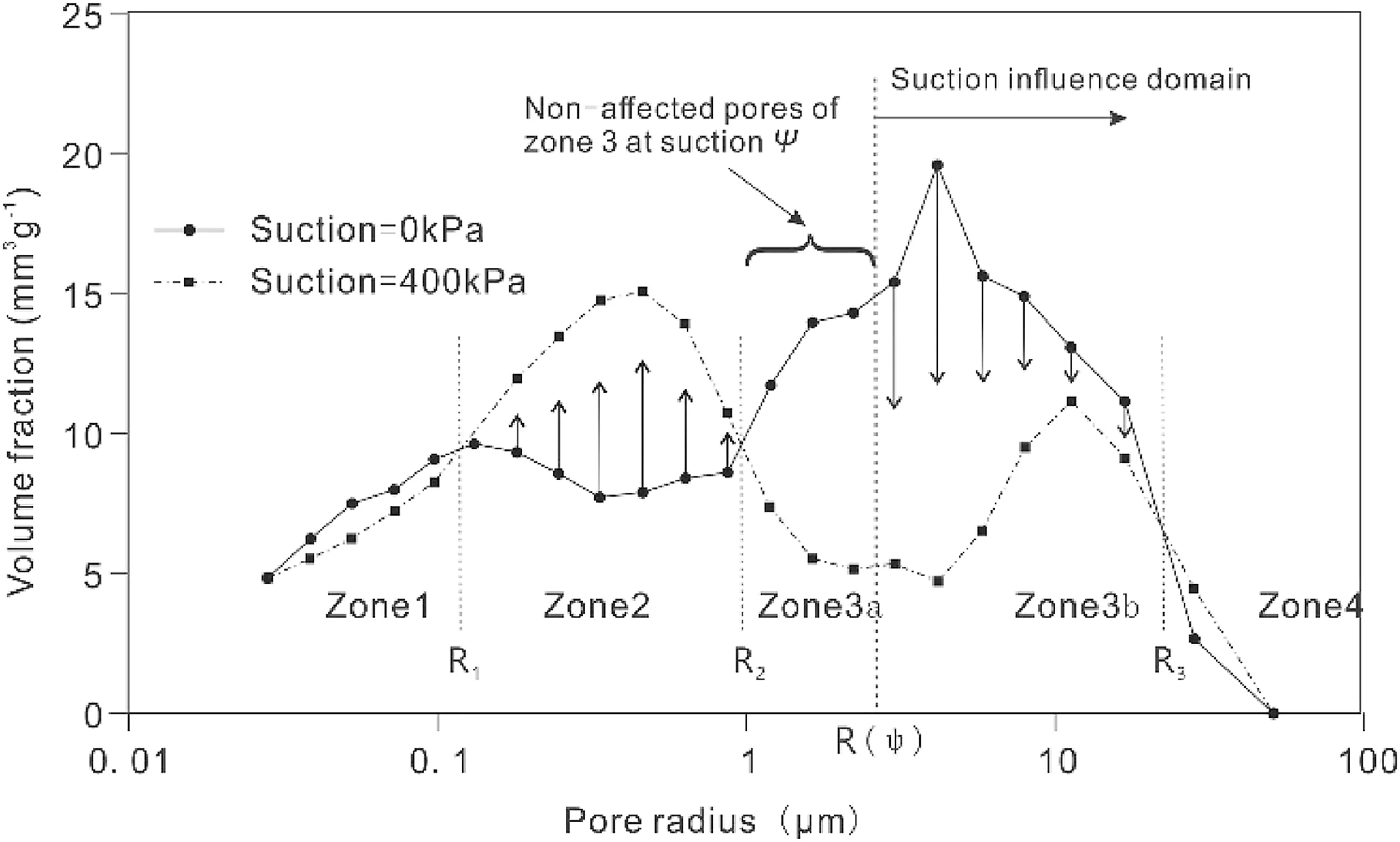
Fig.6.Different zones of pore classes,suction influence domain and evolution of pore classes (Koliji et al.,2006).
In the constant volume wetting process,the change in swelling pressure can also reflect the change in microstructure.Liu (2016)performed the constant volume swelling test for measuring the swelling pressure of Gaomiaozi(GMZ)bentonite and found that the swelling curve of GMZ bentonite is deeply influenced by the volume of the inter-aggregate pores.When the dry density and water content are lower,there is a mass of inter-aggregate pores,and the bentonite aggregates can expand rapidly and form a provisional structure.When the swelling pressure reaches the limit load,the provisional structure collapses,the inter-aggregate pores rapidly decrease,and the corresponding swelling pressure decreases.Continued wetting leads to an increase in swelling pressure.Therefore,a two-peak swelling pressure curve can be observed when the water content is lower.With the water content increasing,the swelling pressure curve becomes smoother.
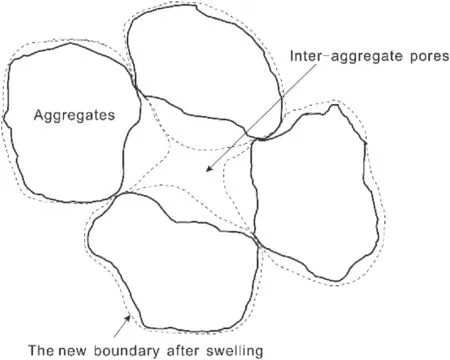
Fig.7.Swelling of aggregates into the inter-aggregate pores during wetting(Sivakumar et al.,2006).
3.3.Wetting/drying cycle
Drying leads to soil shrinkage whereas wetting results in soil swelling.However,changes in soil microstructure caused by these two processes are not completely reversible.There are obvious hysteresis loops in both the SWRC and the volumetric strain curve during the wetting/drying cycle.
On the same evening the bride and bridegroom went on board ship; cannons112 were roaring, flags waving, and in the centre of the ship a costly tent of purple and gold had been erected113
At present,there are two viewpoints on the volumetric strain characteristics of soil in wetting/drying cycle: Dif and Bluemel(1991),Al-Homoud et al.(1995) and Alonso et al.(1995) claimed that there are cumulative shrinkage flaws in the swelling clay after wetting/drying cycles,and the amount of shrinkage increased with the increases of vertical stress.On the contrary,Chu and Mou(1973),Obermeier (1973),Popescu (1980) and Pousada (1982)observed contrasting phenomena in which each wetting/drying cycle leaves a residual volume expansion.In addition,some investigators have found these two phenomena simultaneous occurrence.The reasons are explored: experiments of Day (1994)and Basma et al.(1996) found that expansion or contraction depends on the suction applied during the drying path;Sharma and Wheeler (2000) believed that the results after cycling depend on the stress history and the stress path;Alonso et al.(1999)attributed the different results to stress levels and stress history.
Whether during expansion or shrinkage,volumetric deformation cannot develop indefinitely.As the wetting/drying cycle continues,it will eventually reach an equilibrium state.The subsequent wetting/drying cycle will not result in further cumulative volumetric strain (Nowamooz and Masrouri,2010a) (Fig.8a).Farulla et al.(2010) explained this phenomenon from soil microstructure perspective:after several wetting/drying cycles or in the absence of net vertical stress,there is no accumulated volumetric deformation because only the swelling/shrinkage of the aggregates occurs.This happens without obvious aggregate fusing and slippage.Nowamooz and Masrouri(2010b)measured and defined the micro-,meso-,and macro-pores using nitrogen gas adsorption (BET)techniques and MIP,and compared the porosity of each level at the equilibrium state with that of the initial state.The result is shown in Fig.8b.They used the suction at shrinkage limitsSLas the suction limit of the micro-and meso-pores,i.e.sn/m,and defined another slope change point on the void ratioevs.suctionscurve as the suction boundary of macro-and meso-pores,sm/M.For different numbers of wetting/drying cycles,the shrinkage limit suctionsn/mis the same,and(sm/M)shon the drying path was also constant.Only the limit(sm/M)swof macro-and meso-pores on the wetting path is changed.When the number of wetting/drying cycle increases,(sm/M)swapproaches (sm/M)shgradually,and finally reaches equality.Nowamooz and Masrouri (2010a) predicted that cycling will eventually induce an equilibrium state,at which for any suction,there is a corresponding void ratio.As long as the sample is compacted to this void ratio under this suction,the wetting/drying cycle will be elastic.That is,wetting/drying can no longer produce swelling or shrinkage accumulation.This void ratio is called the elastic void ratioe0el,i.e.e0elis a function of the suctions,irrespective of the number of wetting/drying cycles and the path.From the test results,it was found that many wetting/drying cycles hardly affect micro-and meso-pores.Only macro-pores are changed.When the void ratio is smaller thane0elof dense samples,irreversible volumetric swelling will occur and develop untile0elis reached.In contrast,loose samples with void ratios larger thane0elproduce irreversible volumetric shrinkage untile0elis reached,during which all the volumetric strains come from macro-porosity change.This state is a characteristic equilibrium state of cohesive soils.They suggest that the elastic void ratio can be considered as a new independent parameter of unsaturated soil.These realizations lay the foundation for the establishment of a new soil constitutive model.
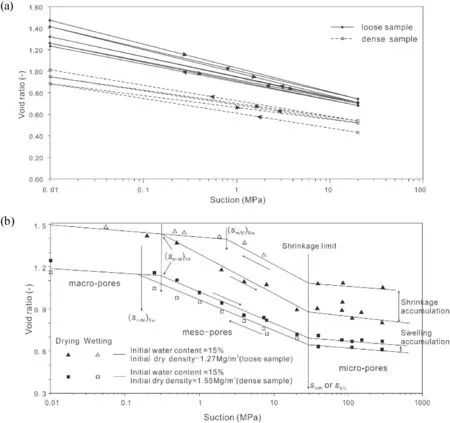
Fig.8.Void ratio variation: (a) Loose and compacted soils during series of wetting and drying cycles (Nowamooz and Masrouri,2010a);and (b) Densely and loosely compacted bentonite and silt mixtures during a single wetting/drying cycle (Nowamooz and Masrouri,2010b).
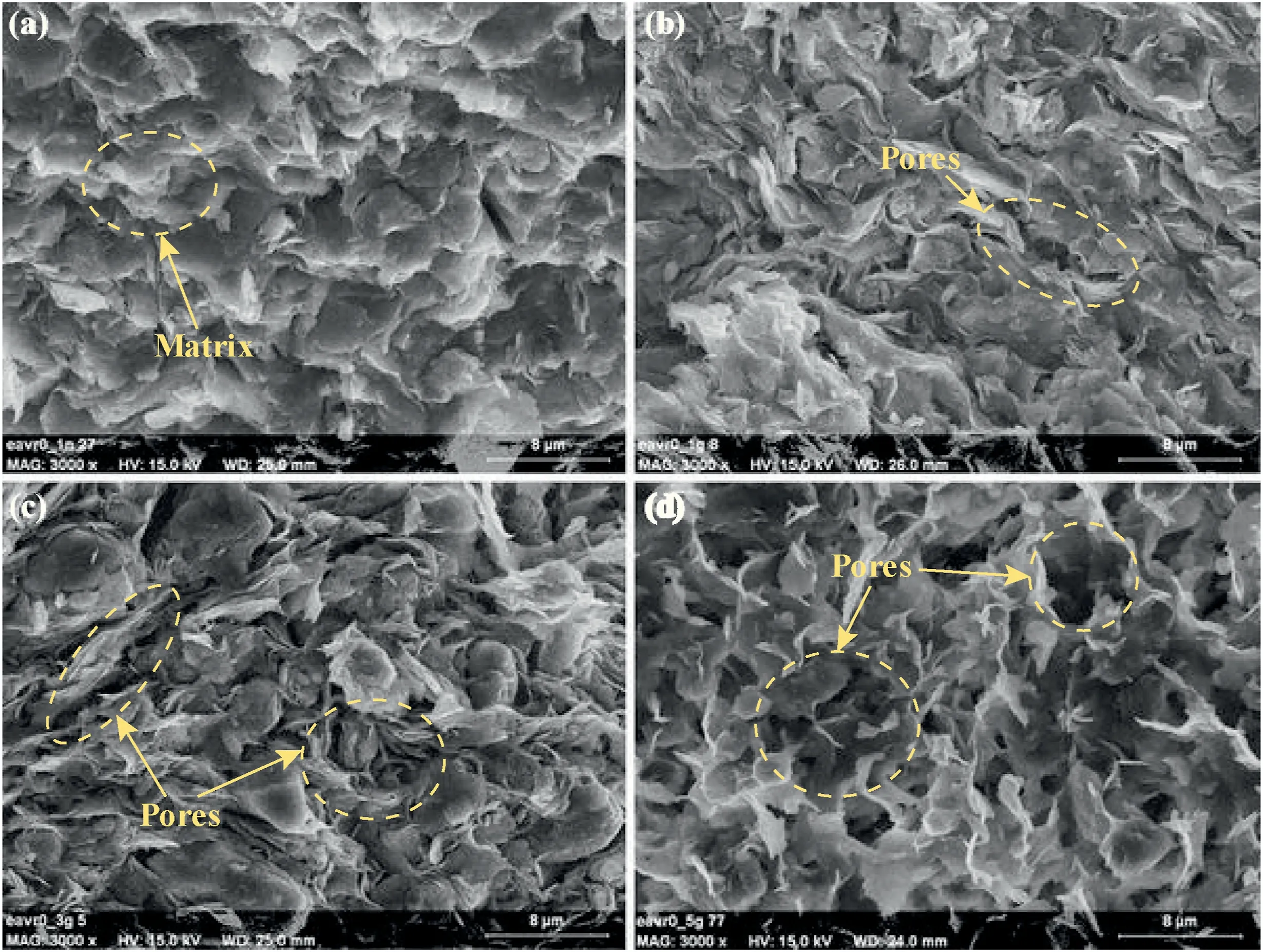
Fig.9.SEM micrographs: (a) Natural state;and (b-d) After 1,3 and 5 cycles of free swelling,respectively (Basma et al.,1996).
Many studies have shown that after complete wetting/drying cycle,the amount of shrinkage/expansion is related to the net vertical stress.If wetting/drying cycling leads to an accumulative shrinkage,the net vertical stress applied is high and the shrinkage is high.Conversely,if the wetting/drying cycling leads to a cumulative swelling,the applied net vertical stress is large and the swelling is small relatively.If there is no net vertical stress,wetting/drying cycling will not produce cumulative volumetric strain,i.e.the volumetric strain caused by wetting/drying cycles is reversible completely (Zeng,2007;Nowamooz and Masrouri,2010b).When there is a net vertical stress,or the wetting/drying cycling has not yet reached the equilibrium state,irreversible aggregate slip or macro-pore collapse will occur,resulting in a decrease in the wetting expansion level and a decrease in macro-pores finally forming a hysteresis loop.The irreversible volume strain caused by each cycle gradually decreases as cycling continues.This occurs because a more stable soil structure forms after each cycle(Farulla et al.,2010).
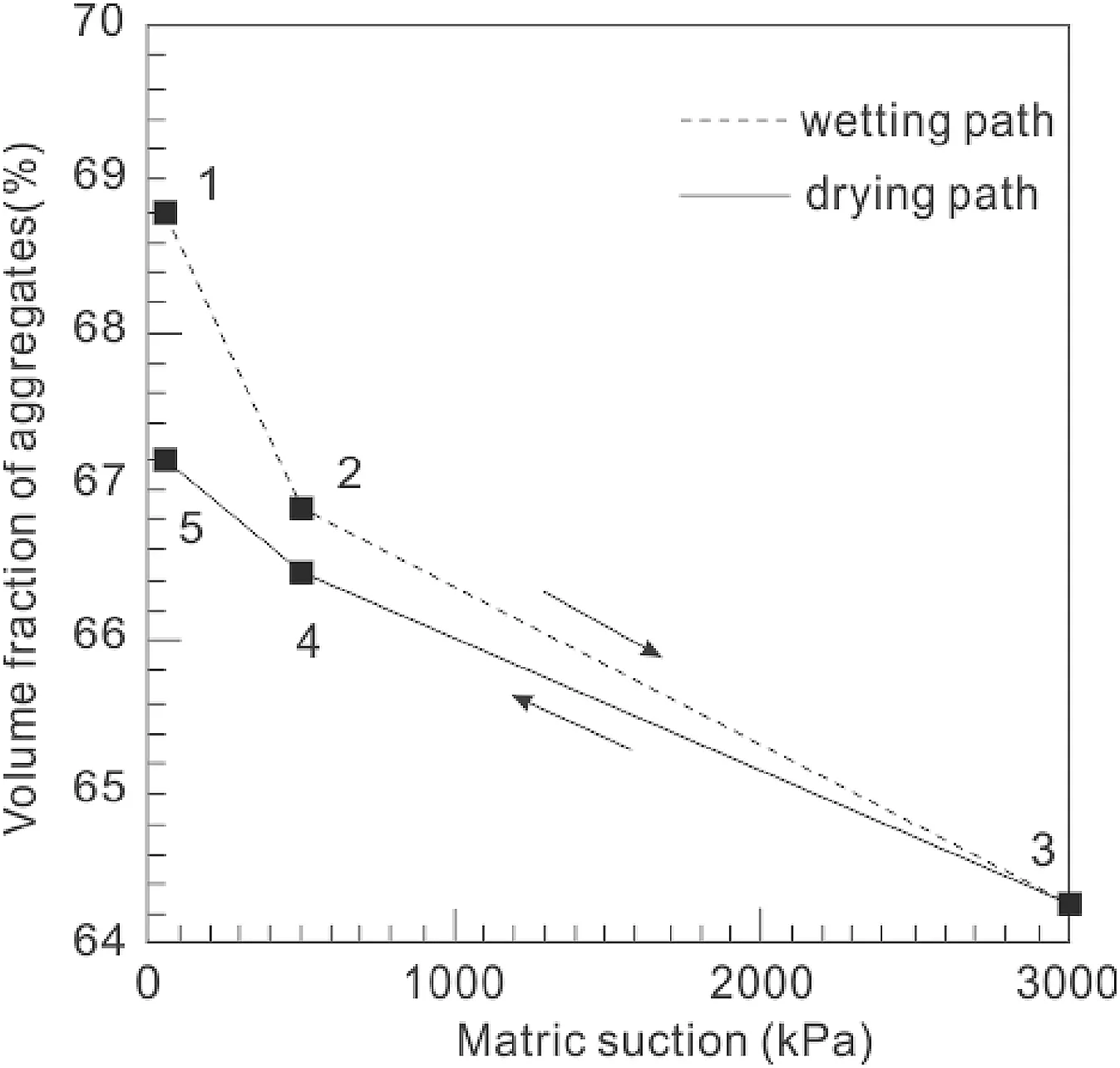
Fig.10.Evolution of aggregate volume with suction in the sample of unsaturated soil(Koliji et al.,2010).
The morphology of the soil particles during the wetting/drying cycle can be studied using SEM/ESEM.Typical results can show orientations of the structural elements that are weakened and the large aggregates that are destroyed by wetting/drying cycles(Zemenu et al.,2009).In the case shown in Fig.9,after soil samples undergo five cycles,their original structures are completely destroyed,and disoriented homogeneous but loose structures form.Koliji et al.(2010) performed quantitative analyses of ESEM images and plotted the volume percentage of aggregates against suction changes(Fig.10).Increase in suction resulted in a decrease in the volume of aggregates.This decrease is most noticeable during the first drying stage(i.e.the increase in suction from 50 kPa to 500 kPa),with smaller changes in volume beyond 500 kPa.
Pires et al.(2005,2007)used γ-ray CT(GCT)to perform a series of investigations on soil structure evolution during wetting/drying cycling.They found that the density of initial sample on the top and the bottom as well the side is greater than that at the middle(presumably due to the force applied during sample preparation);after 3 and 9 wetting/drying cycles,the porosity increased and the density decreased significantly,in particular,on the top,bottom and sides.Wetting/drying cycles increased the anisotropy of PSD,and the volume of macro-pores,large pores,and cracks on the sample surface.Using systematic descriptions,application of statistics to elements on soil slices,and optical microscopic observations,Hussein and Adey (1995,1998) investigated the effects of wetting/drying cycles on soil microstructure.Their results show that wetting/drying cycles cause the reconstituted soils to form complex crumb structure,blocky structure,and platy structure.In their particular studies,the initial structural units became smaller gradually.SR-μCT (synchrotron-based X-ray micro-computed tomography) and digital image processing techniques were applied to analyze changes in soil microstructure during wetting/drying cycles by Ma et al.(2015).They found that wetting/drying cycles result in breakage of aggregates,increase in large pores and decrease in small pores significantly.Total porosity increased continually.Sartori et al.(1985),Pires et al.(2005) and Peng et al.(2007) also obtained similar results in their studies.Pires et al.(2020) revealed that pores in the soil are more well aligned after wetting and drying cycles.Besides,the porosity at the bottom of the sample increased and the pore connectivity improved.The soil submitted to contrasting management practices would respond differently to the action of wetting/drying cycles with a direct influence on water retention and movement due to the induced changes in the soil porous system (De Oliveira et al.,2021).In general,wetting/drying cycles leads to increase in the volume of macro-pores.
Soil microstructure has significant effects on the SWRC.Researchers often use the SWRC to predict the permeability coefficientkof unsaturated soils and evaluate soil mechanical properties.In this process,it is often necessary to consider the combination of soil microstructure and SWRC (Simms and Yanful,2002).Many studies have shown that during the wetting/drying cycles,SWRCs do not completely overlap (Ray and Morris,1995;Ng and Pang,2000;Wheeler et al.,2003;Sivakumar et al.,2006).There is a prominent hysteresis loop,as shown in Fig.11.In a single drying/wetting cycle,saturation on the drying path is usually higher than that on the wetting path at a given suction,and after each cycle,the soil sample has higher water content,i.e.the hysteresis loops of SWRC keep moving up.In general,it tends gradually to stabilize after three cycles(Farulla et al.,2010;Chen and Ng,2013).The main causes are summarized as follows: (1) ink-bottle effect;(2) differences between advancing contact angle and receding contact angle of water-mineral interfaces;(3) differences of residual gas volumes in wetting and drying paths;and (4) cumulative effects and hysteresis characteristics of soil structure and volume deformation.
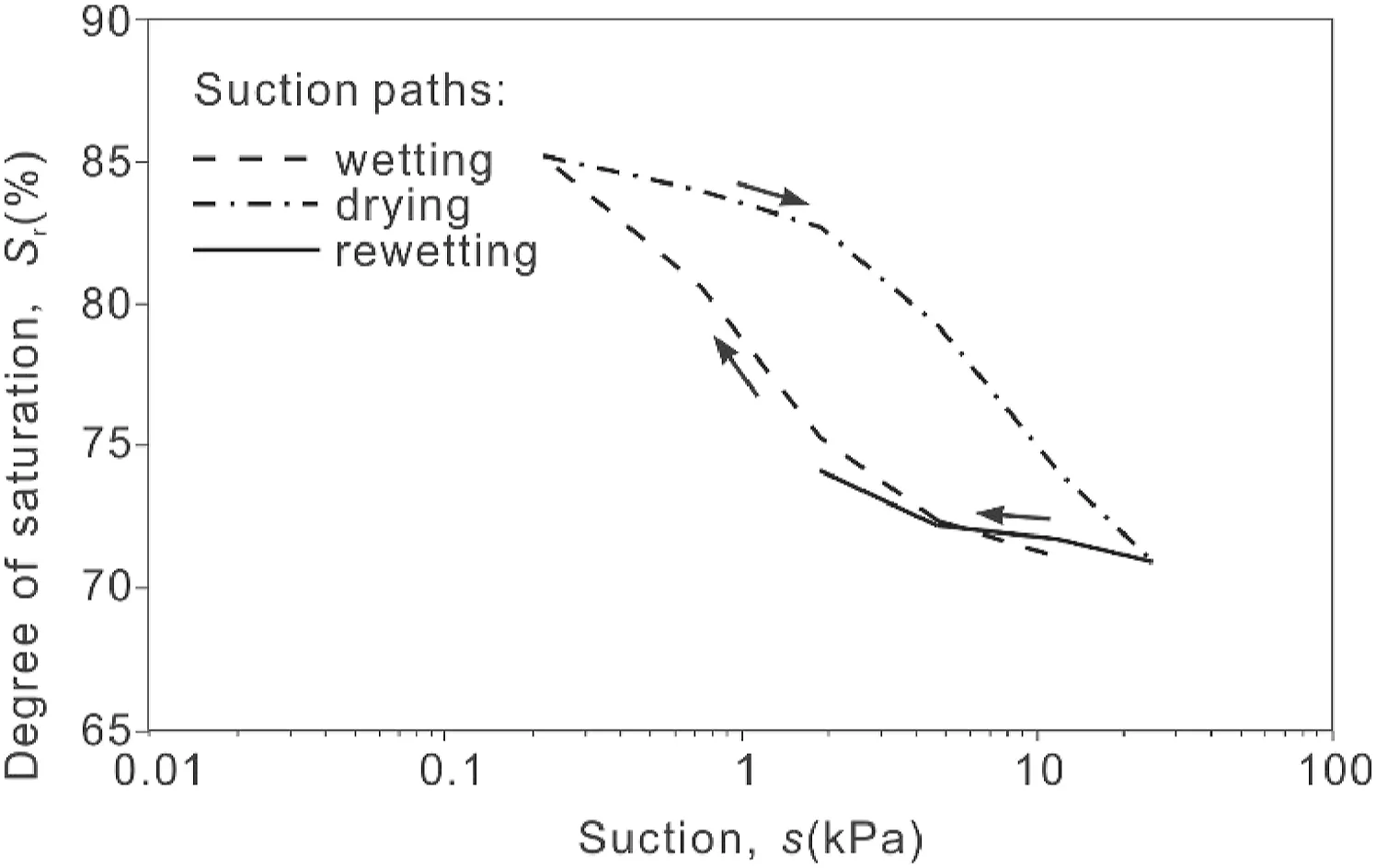
Fig.11.The hysteresis of SWRC during wetting-drying cycles (Gitirana and Fredlund,2004).
There are two kinds of methods that are commonly used to obtain SWRCs:the test method,and the model prediction method.The conventional test method is time-consuming and laborintensive.The data obtained are not continuous.Therefore,improvement of the model prediction method has been the focus of research of many researches.For example,taking the PSD function as a medium,Fredlund-Xing SWRC equation (Fredlund and Xing,1994) is derived based on the relationship between the SWRC and PSD.Simms and Yanful (2002) measured the SWRCs and evolution of the PSDs of four fine-grained compacted soils and developed a method to predict the SWRCs from the PSD data.Cheng et al.(2019)developed a new model to predict both the main drying and wetting paths of SWRC,which incorporated the effects of pore non-uniformity and change in PSD into this model.The empirical formula of a bimodal SWRC proposed by Gitirana and Fredlund (2004) can not only fit different types of soil,but cover parameters with clear physical meaning.Vereecken et al.(1989)fit the characteristics of 40 groups of Belgian soil samples by van Genuchten SWRC equations,and through regression analysis of soil particle size distribution curves,dry density,etc.,and found high predictive capacity for SWRC.Arya et al.(1981) and Zhuang et al.(2001) used the physical modeling method to predict SWRC based on the PSD,density and particle density.This makes the best use of the limited available data.It should be noted that in these models,soil is always assumed to be uniform and soil pores are idealized as parallel cylindrical bundles of tubes and the shape,size and cross-section of each tube remain constant along the length of the tube.The contact angle is assumed to be 0°.
Fractal theory has also been applied to SWRC studies.Soil particle size distribution,pore size,pore connectivity and particle surface area exhibit self-similarity,one of the most important fractal characteristics.Therefore,fractal theory can be used to determine the fractal dimensions of soil microstructures,thus enabling the formulation of descriptive fractal models for SWRC.This can reduce the difficulty of determining parameters in the empirical model (Tyler and Wheatcraft,1990;Rieu and Sposito,1991).Beckett and Augarde (2013) improved the previous model by assuming a more realistic arrangement of soil particles that accounts for material porosity,whilst retaining the effect of adsorbed water on the SWRC introduced in Tuller et al.(1999)and Likos (2009).They compared the prediction with the actual situation and proposed the limitation of using PSD to predict retention properties.Russell (2014) gave an analytical derivation of all parameters that define SWRCs along with particle and pore geometric information,size distribution,shape,volume,and surface area.He found that a SWRC for a single void ratio can be made applicable to any other void ratio using just the particle size distribution.
4.The constitutive model related to soil microstructure
One of the important goals of studying soil microstructure evolution is to explain the macroscopic phenomena using soil microstructure,and to establish the appropriate theoretical model.Over the past few decades,investigators have proposed many different elasto-plastic constitutive models for describing the mechanical behavior of unsaturated soils.The most widely accepted one is the one proposed by Alonso et al.(1987,1990)and the BBM which is a generalization of the modified Cambridge model(Roscoe,1968) to unsaturated soils.Subsequently,Alonso’s team also improved the BBM model,making it also applicable to expansive soils.The latter is known as BExM (Gens and Alonso,1992;Alonso et al.,1999,2005).The establishment of the BExM is based on the recognition that there exist micro-and macro-pore structures in compacted expansive soils,i.e.micro-pores are considered to be saturated,and their deformation is controlled by effective stress,thus introducing the neutral line(NL).As shown in Fig.12a,a 45°inclined line indicates that there is no deformation of the microstructure in this state.
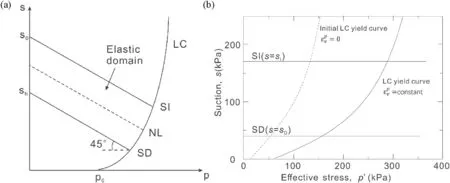
Fig.12.Yield surfaces proposed by (a) Alonso et al.(1999) and (b) Nowamooz and Masrouri (2009).
Considering the large number of parameters in BExM and the difficulty of its application,Li et al.(2018) proposed a simplified method: the Shakedown-based model based on the Zarka theory(Zarka and Casier,1981) in order to fit the hydro-mechanical behavior of unsaturated expansive soils during a series of wetting/drying cycles.The proposed shakedown model requires three parameters:the linear evolution law of elasticity parameters(1/Er);the linear evolution law of hardening modulus (1/h);and the threshold of the elastic limit during suction variation,usually taken as zero for simplicity.
Since the Bishop’s unsaturated soil strength formula,many investigators have tried to express the effective stress parameter χ as a function of saturationSr,and have carried out many tests to verify it.However,because soil pores have multiple levels,and their mechanical properties in different states are not the same,Nowamooz(2014)and Nowamooz et al.(2016)attempted to fit χ in Bishop’s formula using the macro-,meso-and microscales in interaction.The expression is summarized in Table 3.
Research and development of constitutive models related to the microstructure of unsaturated soils are mainly focused on the understanding of structure and suction of soils.Deep understanding of the evolutionary characteristics of soil microstructures in wetting/drying cycles and their intrinsic correlation with macroscopic hydro-mechanical properties are the targets for the study of constitutive modeling of unsaturated soils under wetting/drying conditions.
5.Conclusions and prospect
5.1.Conclusions
This article first explores some concepts related to soil microstructure and techniques applied in the study of soil microstructure.Then,it focuses on the evolution of soil microstructure during drying,wetting,and wetting/drying cycles.Advances in related constitutive model is introduced.This review sheds light on the following:
(1) The academic community has not formed a unified view on the definition of soil microstructure,the meaning of related terms,and classification criteria.There are also significant differences among different disciplines in the use of terms.
(2) Water content is one of the key factors that affect soil microstructure.The PSD curve of a soil sample compacted on the dry side of optimum moisture content is typically bimodal while it is unimodal on the wet side.
(3) In the drying process(suction increase),the soil shrinkage is mainly caused by decrease in macro-pores.After reaching shrinkage limit,the internal pore structure of the soil is still adjusting although the total porosity remains constant.In different suction ranges,different size ranges of pores are affected.
(4) In the wetting process (suction decrease),the meso-and macro-pores gradually expand,and the expansion of the latter is dominant.The evolution of soil structure is closely related to confining conditions.
(5) During wetting/drying cycling,the soil microstructure evolution is not completely reversible.The cumulative shrinkage/expansion deformation mainly derives from changes in macro-pore volumes.With increase in the number of wetting/drying cycles,the volumetric deformation will reach an equilibrium state.
(6) Deep understanding of the evolution of soil microstructure during wetting/drying and its intrinsic correlation with macroscopic hydro-mechanical properties is a necessity for establishing the constitutive model of unsaturated soils under wetting/drying conditions.The successful application of the BBM,BExM and many other related models has benefited from an in-depth understanding of soil microstructure and deformation mechanisms.
5.2.Prospects
Appreciation of microstructure and small-scale deformation processes is a necessity for scaling of the macro-characteristics of soils.Despite the fact that much research has been performed on soil microstructure during wetting/drying process,there are still many aspects that need further research.Among them are the following:
(1) Improvement of sampling and observation techniques in soil microstructure research.In order to reflect the evolution of soil microstructure during wetting/drying cycles,the most intuitive way is to perform a dynamic,continuous monitoring or observation of the soil microstructure.However,current technical methods(such as SEM,ESEM and MIP)are mainly static and separate.Thus,it is difficult to achieve realtime 3D and dynamic observation.In recent years,CT has gradually been used for 3D dynamic observation of soil structure and spatial resolution further improved(Tippkötter et al.,2009),but the relatively longer scanning and complicated post-processing make this method timeconsuming and computationally expensive.Considering that CT is powerful,adaptable to soil samples,and can identify the internal microstructure of the soil sample,it is believed that it should be a promising direction for research.
(2) Wetting process needs to be further studied.There is a huge difference between soil wetting and drying processes.The latter is characterized by slowness and quasi-static state.It is relatively easy to study.Previous investigators have focused on the drying process much more than the wetting process.The latter is often very rapid and difficult to observe in small time segments.In addition,there are many different types of wetting in nature (such as rainfall wetting,slow humidity wetting,slow capillary wetting,fast capillary wetting and rapid flood wetting) (Hussein and Adey,1995).Different wetting methods also lead to different evolutionary characteristics of soil structure.At present,research focusing on this aspect is inadequate.
(3) The macroscopic properties of a soil depend enormously on its microstructure.Processes can be better understood by integrating existing macro-mechanical models,with probing methods.This requires advances in portability of microscopic instruments.
(4) The evolution of soil microstructure under multi-field coupling is another aspect on which additional research is needed.Soils in the field or in engineering structures often experience multi-field coupled stresses such as heat-waterforce-chemistry,and even microbial attack.Therefore,its microstructural response is also complex at various scales.Understanding of macroscopic response requires in-depth study of the evolution of soil microstructure under multifield coupling of stresses.
Declaration of competing interest
The authors declare that they have no known competing financial interests or personal relationships that could have appeared to influence the work reported in this paper.
Acknowledgments
This work was supported by National Natural Science Foundation of China(Grant Nos.41925012 and 41902271),Natural Science Foundation of Jiangsu Province (Grant No.BK20211087).
List of symbols and abbreviations
dPore diameter
eVoid ratio
e0elElastic void ratio
ErElasticity parameter
hHardening modulus
pCompaction pressure
p′Effective stress
PIntrusion pressure
rPore size
sMatricuction
sm/MSuction boundary of macro-and meso-pores
sn/mSuction boundary between meso-and micro-structure
sSLSuction at shrinkage limit
(sm/M)shShrinkage limit suction on the drying path
(sm/M)swSwelling limit suction on the wetting path
SrSaturation
uwPore water pressure
γ Liquid surface tension
θ Contact angle
κ Elastic stiffness parameter for changes in net mean stress
χ Effective stress parameter
ψ Total suction
BBM Barcelona Basic Model
BExM Barcelona Expansive Model
CT Computer tomography
ESEM Environmental scanning electron microscope
GCT γ-ray computed tomography
MIP Mercury intrusion porosimetry
PSD Pore size distribution
SD Suction decrease
SEM Scanning electron microscope
SI Suction increase
SR-μCT Synchrotron-based X-ray micro-computed tomography
SWRC Soil-water retention curve
XRD X-ray diffraction
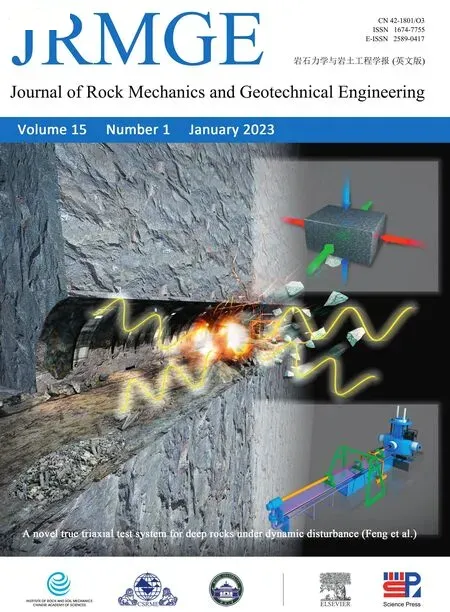 Journal of Rock Mechanics and Geotechnical Engineering2023年1期
Journal of Rock Mechanics and Geotechnical Engineering2023年1期
- Journal of Rock Mechanics and Geotechnical Engineering的其它文章
- Aims &Scope
- Discussion on “Impact of orientation of blast initiation on ground vibrations” [J Rock Mech Geotech Eng 15 (2022) 255-261]
- Impact of orientation of blast initiation on ground vibrations
- Unified description of different soils based on the superloading and subloading concepts
- Self-sealing of fractures in indurated claystones measured by water and gas flow
- Saturated hydraulic conductivity of compacted bentonite-sand mixtures before and after gas migration in artificial seawater
